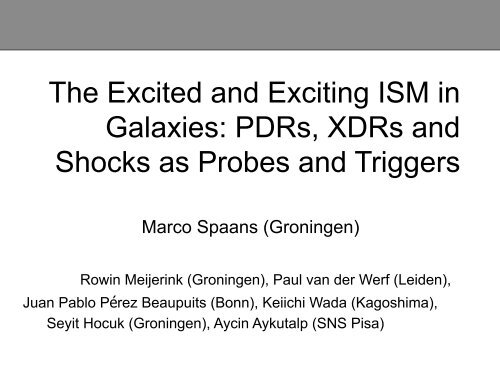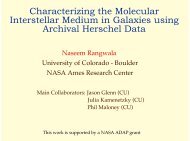The Excited and Exciting ISM in Galaxies: PDRs, XDRs ... - Caltech
The Excited and Exciting ISM in Galaxies: PDRs, XDRs ... - Caltech
The Excited and Exciting ISM in Galaxies: PDRs, XDRs ... - Caltech
Create successful ePaper yourself
Turn your PDF publications into a flip-book with our unique Google optimized e-Paper software.
<strong>The</strong> <strong>Excited</strong> <strong>and</strong> <strong>Excit<strong>in</strong>g</strong> <strong>ISM</strong> <strong>in</strong><br />
<strong>Galaxies</strong>: <strong>PDRs</strong>, <strong>XDRs</strong> <strong>and</strong><br />
Shocks as Probes <strong>and</strong> Triggers<br />
Marco Spaans (Gron<strong>in</strong>gen)<br />
Row<strong>in</strong> Meijer<strong>in</strong>k (Gron<strong>in</strong>gen), Paul van der Werf (Leiden),<br />
Juan Pablo Pérez Beaupuits (Bonn), Keiichi Wada (Kagoshima),<br />
Seyit Hocuk (Gron<strong>in</strong>gen), Ayc<strong>in</strong> Aykutalp (SNS Pisa)
Concentrate on irradiated<br />
turbulent gas <strong>in</strong> starform<strong>in</strong>g<br />
regions <strong>and</strong> close<br />
to AGN ↔ feedback<br />
<strong>PDRs</strong> (UV/SB)<br />
<strong>XDRs</strong> (X-ray/AGN)<br />
CDRs (SNe)<br />
Shocks
<strong>PDRs</strong>: 6 < E < 13.6 eV<br />
Heat<strong>in</strong>g: Photo-electric emission from<br />
gra<strong>in</strong>s <strong>and</strong> cosmic rays<br />
Cool<strong>in</strong>g: F<strong>in</strong>e-structure l<strong>in</strong>es like<br />
[OI] 63, 145; [CII] 158 µm <strong>and</strong> emission by<br />
H2, CO, H2O<br />
10 eV photon penetrates 0.5 mag of dust<br />
Heat<strong>in</strong>g efficiency ~ 0.1 – 1.0 %
<strong>XDRs</strong>: E > 1 keV<br />
Heat<strong>in</strong>g: X-ray photo-ionization --><br />
fast electrons - Coulomb heat<strong>in</strong>g<br />
H <strong>and</strong> H 2vib excitation - UV<br />
Cool<strong>in</strong>g: [FeII] 1.26, 1.64; [OI] 63;<br />
[CII] 158; [SiII] 35 µm; thermal H 2vib; gas-dust<br />
1 keV photon penetrates 10 22 cm -2 of N H<br />
Heat<strong>in</strong>g efficiency ~ 10 – 50 %
Energetics<br />
G0 = 1.6x10 -3 erg cm -2 s -1 Hab<strong>in</strong>g flux over 6-13.6 eV<br />
Orion Bar has 10 5 G 0<br />
F X = 84 L44 r2 -2 erg cm -2 s -1<br />
X-ray flux over 1-100 keV with a power law E -0.9<br />
Th<strong>in</strong>k of Seyfert nucleus at 100 pc
PDR (left) with n=10 5.5 cm -3 , G 0 =10 5<br />
XDR with n=10 5.5 cm -3 , F X =160 erg s -1 cm -2<br />
Note N H dependence H 2 , C + , C, CO, OH, etc.
F<strong>in</strong>e-structure<br />
l<strong>in</strong>es<br />
(Kaufman et al. 1999;<br />
Meijer<strong>in</strong>k et al. 2007)
J=16-15 at 1841 GHz (0.16 mm)<br />
(Spaans & Meijer<strong>in</strong>k 2008)
Comment on AGN: Relative Size<br />
PDR/XDR<br />
10 7 M๏ BH at<br />
3% Edd<strong>in</strong>gton<br />
for G 0 =100 <strong>and</strong><br />
1-100 keV<br />
powerlaw of<br />
slope -1 (with<br />
10% L bol ;<br />
Schleicher ea 10)
E.g., circumnuclear torus with SN feedback <strong>and</strong> a<br />
supermassive black hole, note the warm gas<br />
(Wada ea 09)
Aykutalp &<br />
Spaans 2011
This allows one to<br />
generate atomic<br />
<strong>and</strong> molecular l<strong>in</strong>e<br />
maps at ALMA<br />
resolution (Pérez-<br />
Beaupuits ea 01).
[CII] 158 µm<br />
only for z>1<br />
of course
Hocuk &<br />
Spaans 2010
Hocuk &<br />
Spaans 2010
<strong>The</strong> T-n phase diagram<br />
Gas that is ly<strong>in</strong>g beh<strong>in</strong>d the high densities<br />
is shielded <strong>and</strong> cold (but >10 K)<br />
color represents<br />
column density
<strong>The</strong> Initial Mass Function<br />
Without X-rays With X-rays<br />
"Very good fit to Chabrier<br />
"Much flatter slope<br />
"Higher (characteristic) masses
Metallicity &<br />
Multi-Phase<br />
<strong>ISM</strong>:<br />
Lower metallicity<br />
yields smaller<br />
molecular clouds<br />
X-factor: CO/H 2<br />
Mihos et al. (1999), Bolatto et al.<br />
(1999), Roellig et al. (2006)
H 2 dom<strong>in</strong>ates for Z
Effects of CRs?<br />
One often has a UV irradiated cloud edge<br />
PDR model with CR rate = 5x10 -15 s -1 ; so SN rate for ~100 M 0 /yr<br />
Note changes <strong>in</strong> C, OH <strong>and</strong> H 2 O
BUT: CRs ≠ X-rays;<br />
only very high CR<br />
rates boost OH +<br />
<strong>and</strong> H 2 O + (f<strong>in</strong>estructure<br />
l<strong>in</strong>es little<br />
affected by CRs)
CR protons upto 100<br />
MeV: H 2 ionization,<br />
while 1-20 GeV CRs<br />
responsible for bulk of<br />
π 0 mesons → 2γ <strong>and</strong>,<br />
e.g., pp→pnπ +
How about<br />
shocks?<br />
M82, shock tracer<br />
SiO 2-1 + 4.8<br />
GHz radio<br />
(García-Burillo et<br />
al. 2001, IRAM<br />
PdB)
J-Shocks of > 50 km/s lead to high compression,<br />
molecule dissociation <strong>and</strong> reformation <strong>in</strong> the<br />
shock wake; C-shocks are more gentle
J-shock chemistry
Mrk 231; SPIRE, IR pump<strong>in</strong>g<br />
of water l<strong>in</strong>es by dust emission<br />
(González-Alfonso ea 10)<br />
APM 08279+5255<br />
Lensed QSO (3 images); SMBH 10 9.5 M o<br />
z=3.9; water ~ dust ~ 220 K<br />
Lens<strong>in</strong>g magnification µ = 4<br />
(van der Werf ea 11)
HerCULES<br />
Herschel Comprehensive ULIRG Emission<br />
Survey (PI: van der Werf)<br />
Measure gas cool<strong>in</strong>g l<strong>in</strong>es <strong>in</strong> a flux-limited<br />
sample of 29 (U)LIRGs; high-z template<br />
Observations:<br />
High resolution SPIRE FTS: CO, [CI], [NII], etc.<br />
PACS: [CII] 158µm, [OI] 63 <strong>and</strong> 146 µm<br />
All targets observed to same (expected) S/N<br />
Extended sources observed at several positions
Markarian 231 (van der Werf ea 13)<br />
Perfect test case:<br />
Most lum<strong>in</strong>ous ULIRG <strong>in</strong> sample (L IR = 4x10 12 L סּ )<br />
Optically visible AGN/XDR [Boksenberg et al., 1977]<br />
L X =6x10 43 erg/s (2-10 keV)<br />
~500-1000 pc CO & star formation/PDR disk<br />
Observed dur<strong>in</strong>g SDP:<br />
SPIRE high resolution<br />
<strong>in</strong> both b<strong>and</strong>s<br />
Total on source<br />
time: ~2 hrs<br />
[Spaans & Meijer<strong>in</strong>k, 2008]<br />
[Downes & Solomon 1998, Taylor et al., 1999]
Markarian 231<br />
25 l<strong>in</strong>es:<br />
9x CO<br />
(5-4 to 13-12)<br />
2x [CI]<br />
[NII]<br />
7x H 2 O<br />
3x OH +<br />
H 2 O +<br />
CH +<br />
HF
Markarian 231<br />
25 l<strong>in</strong>es:<br />
9x CO<br />
(5-4 to 13-12)<br />
2x [CI]<br />
[NII]<br />
7x H 2 O<br />
3x OH +<br />
H 2 O +<br />
CH +<br />
HF
Markarian 231<br />
25 l<strong>in</strong>es:<br />
9x CO<br />
(5-4 to 13-12)<br />
2x [CI]<br />
[NII]<br />
7x H 2 O<br />
3x OH +<br />
H 2 O +<br />
CH +<br />
HF
Markarian 231<br />
25 l<strong>in</strong>es:<br />
9x CO<br />
(5-4 to 13-12)<br />
2x [CI]<br />
[NII]<br />
7x H 2 O<br />
3x OH +<br />
H 2 O +<br />
CH +<br />
HF
Markarian 231<br />
25 l<strong>in</strong>es:<br />
9x CO<br />
(5-4 to 13-12)<br />
2x [CI]<br />
[NII]<br />
7x H 2 O<br />
3x OH + (not <strong>in</strong><br />
H 2 O + Orion Bar!)<br />
CH +<br />
HF<br />
1400 km/s OH bulk<br />
outflow (Fischer ea 10)<br />
~1% of L IR (~10 8 Mסּ)
500 pc<br />
Model feedback zone<br />
Mrk 231 3 ma<strong>in</strong> components:<br />
150 pc<br />
PDR 1:<br />
n=10 3.5 , G 0 =10 2 , r~500pc<br />
Large scale molecular gas<br />
à Low-J CO l<strong>in</strong>es<br />
PDR 2:<br />
n=10 5 , G 0 =10 3.5<br />
Small, dense SF clumps<br />
à mid-J CO l<strong>in</strong>es<br />
XDR:<br />
n=10 4.2 , F X =28 cgs, r~150pc<br />
Circum-nuclear disk<br />
à High-J CO, OH + , H2O +
NGC 6240 (Meijer<strong>in</strong>k ea 13)
L<strong>in</strong>e SEDs similar, but…<br />
AGNs NGC6240<br />
contribute 10-15%<br />
to total power,<br />
when look<strong>in</strong>g at<br />
geometry of the<br />
two nuclei: CO <strong>in</strong><br />
the middle
Shocks drive high-J CO excitation<br />
High l<strong>in</strong>e-to-cont<strong>in</strong>uum diagnostic for presence of<br />
shocks (H 2 O, H 2 O + , OH + help as well <strong>in</strong> this)<br />
C-type, transverse<br />
magnetic field =<br />
bn 1/2 µG (b=1-5)<br />
H 2 v=1-0 S(1) <strong>and</strong><br />
v=2-1 S(1) require<br />
v s ~ 50 km s -1 , but<br />
for ~1% of the gas
Conclusions<br />
Future of HerCULES is very excit<strong>in</strong>g<br />
Can dist<strong>in</strong>guish <strong>PDRs</strong>, <strong>XDRs</strong>, CDRs, shocks<br />
With ALMA one can further get:<br />
Dynamical masses <strong>in</strong> NLR <strong>and</strong> BLR<br />
Accretion rates<br />
Edd<strong>in</strong>gton <strong>and</strong> star formation efficiencies<br />
Quantitative measures of local feedback



